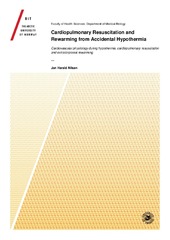Blar i forfatter "Nilsen, Jan Harald"
-
Autoregulation of Cerebral Blood Flow During 3-h Continuous Cardiopulmonary Resuscitation at 27°C
Valkov, Sergei; Nilsen, Jan Harald; Mohyuddin, Rizwan; Schanche, Torstein Lindahl; Kondratyev, Timofey; Sieck, Gary C.; Tveita, Torkjel (Journal article; Tidsskriftartikkel; Peer reviewed, 2022-06-09)Introduction: Victims of accidental hypothermia in hypothermic cardiac arrest (HCA) may survive with favorable neurologic outcome if early and continuous prehospital cardiopulmonary resuscitation (CPR) is started and continued during evacuation and transport. The efficacy of cerebral autoregulation during hypothermic CPR is largely unknown and is aim of the present experiment.<p> <p>Methods: ... -
Cardiopulmonary Resuscitation and Rewarming from Accidental Hypothermia
Nilsen, Jan Harald (Doctoral thesis; Doktorgradsavhandling, 2022-03-11)This thesis springs from 3 different papers: Paper 1 A randomised controlled study in rats to investigate whether an infusion of crystalloids or colloids during rewarming from hypothermia could alleviate the alterations in cardiovascular function seen in untreated control animals. Paper 2 A randomised controlled study in pigs, examining normothermic vs hypothermic cardiopulmonary resuscitation (CPR). ... -
Effects of rewarming with extracorporeal membrane oxygenation to restore oxygen transport and organ blood flow after hypothermic cardiac arrest in a porcine model
Nilsen, Jan Harald; Schanche, Torstein Lindahl; Valkov, Sergey; Mohyuddin, Rizwan; Håheim, Brage; Kondratyev, Timofey; Næsheim, Torvind; Sieck, Gary C.; Tveita, Torkjel (Journal article; Tidsskriftartikkel; Peer reviewed, 2021-09-23)We recently documented that cardiopulmonary resuscitation (CPR) generates the same level of cardiac output (CO) and mean arterial pressure (MAP) during both normothermia (38 °C) and hypothermia (27 °C). Furthermore, continuous CPR at 27 °C provides O2 delivery (ḊO2) to support aerobic metabolism throughout a 3-h period. The aim of the present study was to investigate the effects of extracorporeal ... -
Maintaining intravenous volume mitigates hypothermia-induced myocardial dysfunction and accumulation of intracellular Ca2+
Nilsen, Jan Harald; Schanche, Torstein; Kondratiev, Timofei V.; Hevrøy, Olav; Tveita, Torkjel; Sieck, Gary C. (Journal article; Tidsskriftartikkel; Peer reviewed, 2021-03-17)Previous research exploring pathophysiological mechanisms underlying circulatory collapse after rewarming victims of severe accidental hypothermia has documented post-hypothermic cardiac dysfunction and hypothermia-induced elevation of intracellular Ca<sup>2+</sup> concentration ([Ca<sup>2+</sup>]<sub>i</sub>) in myocardial cells. The aim of the present study was to examine if maintaining euvolaemia ... -
Rewarming With Closed Thoracic Lavage Following 3-h CPR at 27°C Failed to Reestablish a Perfusing Rhythm
Nivfors, Joar O.; Mohyuddin, Rizwan; Schanche, Torstein; Nilsen, Jan Harald; Valkov, Sergei; Kondratiev, Timofei V.; Sieck, Gary C.; Tveita, Torkjel (Journal article; Tidsskriftartikkel; Peer reviewed, 2021-09-29)Introduction: Previously, we showed that the cardiopulmonary resuscitation (CPR) for hypothermic cardiac arrest (HCA) maintained cardiac output (CO) and mean arterial pressure (MAP) to the same reduced level during normothermia (38°C) vs. hypothermia (27°C). In addition, at 27°C, the CPR for 3-h provided global O2 delivery (DO2) to support aerobic metabolism. The present study investigated if rewarming ... -
Study of the effects of 3 h of continuous cardiopulmonary resuscitation at 27°C on global oxygen transport and organ blood flow
Nilsen, Jan Harald; Valkov, Sergei; Mohyuddin, Rizwan; Schanche, Torstein Lindahl; Kondratiev, Timofei V.; Næsheim, Torvind; Sieck, Gary C.; Tveita, Torkjel (Journal article; Tidsskriftartikkel; Peer reviewed, 2020-04-16)<i>Aims</i>: Complete restitution of neurologic function after 6 h of pre-hospital resuscitation and in-hospital rewarming has been reported in accidental hypothermia patients with cardiac arrest (CA). However, the level of restitution of circulatory function during long-lasting hypothermic cardiopulmonary resuscitation (CPR) remains largely unknown. We compared the effects of CPR in replacing ...


 English
English norsk
norsk




